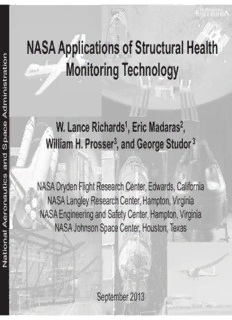Table Of Contenthttps://ntrs.nasa.gov/search.jsp?R=20140010525 2018-11-29T17:50:36+00:00Z
NASA Applications of Structural Health
n
o
Monitoring Technology
i
t
a
r
t
s
i
n
i
m
d
A
e W. Lance Richards1, Eric Madaras2,
c
a
p William H. Prosser3, and George Studor 3
S
d
n
a
s
c
NASA Dryden Flight Research Center, Edwards, California
i
t
u
a NASA Langley Research Center, Hampton, Virginia
n
o
NASA Engineering and Safety Center, Hampton, Virginia
r
e
A
NASA Johnson Space Center, Houston, Texas
l
a
n
o
ti
a
N
September 2013
NASA Focused Structural Health Monitoring
n
o
Key Drivers Enabling
i
t
a
r Vehicle-focused Technologies
t Structures
s
ni Real-time, Advanced Sensing
i
m
decision-making - Multi-parameter
d
A
Online processing - Sensor arrays
e
c Onboard systems Advanced Systems
a
p Lightweight, and Processing
S
d Small size, SHM - Solid state
n
a Low power, - Rugged
s
c System solutions Materials NDE - High Speed
i
t
u Ultra-Efficient
a
n Algorithms
o
r
e
A
l
a
n
o
i
t
a
N
SHM Aerospace Vehicle Applications
n
o
i
t
a
r
t
s
i
n Sppaaccee SShhhhhuuuuttttttttttllllleee
i
m
Orbiteeerrr
d Intteerrnnaattiiiooonnnaaaall
A
SSppaaccccceeeee
LLaauunncchhhhh
e
c Stationnn
Vehicleeesss
a
p
S NASA
d
n
Structural
a VVVeeehhhiiicccllleeeeeee CCCooommmpppoooosssssiitttteeee
s
c PPrreessssuurrrrrreeee Health CCCCCrrrrreeeeewwwwwwwwww
i
t
u SSyystemmmmssss MMMoooddduuuullllllleee
a Monitoring
n
o
r Technology
e
A
UUnniinnhhaabbiitteeddd
RReeeennttrrrryyyy
l
a
Aerial Vehicleeesss
n VVVeeehhiicclleeeesss
o
ti
a
N
Space Vehicleess
3
Topics
n
o •
Structural Health Monitoring
i
t
a
r –
t Definition
s
i
n
–
i SHM vs NDE
m
d
•
A Agency Overview of SHM Activities
e
c – Accel & Acoustic-based SHM on STS (Prosser, NESC)
a
p
S – Wireless-based SHM on ISS / STS (Studor, JSC)
d
n –
Piezo-based SHM on ISS (Madaras, LaRC)
a
s
–
c Fiber-optic-based SHM on Aerospace Vehicles (Richards, DFRC)
i
t
u
•
a Uninhabited Aerial Vehicles
n
o •
Composite Crew Module
r
e
A •
Reentry Vehicles
l
a
•
n Space Vehicles
o
i
t •
a Vehicle Pressure Systems
N
•
Expendable Launch Vehicles
4
Space Shuttle Orbiter
Wing Leading Edge Impact Detection System (WLEIDS)
n
o
i
t
a
r
t
s
i
n
i
m
d
A
e
c
a
p
S
d
n
a
s
c
i
t
u
a
n
o
r
e
A
l
a
n
o
i
t
a
N
Wing Leading Edge Impact Detection System
(WLEIDS) Development
•
Columbia accident investigation testing
- Recovery of DFI sensor data on MADS focused impact testing
on RCC
•
Additional impact testing
- Ascent impacts
- MMOD impacts
•
Vehicle testing
•
System development and implementation
•
Flight results
Columbia Accident Investigation
Catastrophic Impact Damage Test on RCC Panel 8
July 7, 2003
AE
Accelerometers
Sensors
1 2 3 4 5 6 7
J1
J2
J3
8
Triax Panel 5 Panel 6 Panel 7 Panel 8 Panel 9 Panel 10
400.00
Acoustic Emission Sensor Data Impact on Panel #8:
Broken Panel
1 2
350.00
331.71
310.81
3 4
300.00
254.73
5 6
250.00 236.03
Peak g’s
200.00
7 8
150.00
136.60
100.00
67.55
61.33
32.35 52.54 57.01 42.68
50.00 22.89 18.40 32.57 31.47 38.43 35.89
2148..1187 26.60 23.1848. 39 33.00 30.75 22.15 47.53 29.19 25.76
37.2 37.2
Air Blast Test 6.7 7.3 7.3 7.9 7.9 20.9 20.9 24.3 24.3 24.2
0.00
Accelerations
WLEIDS Operations
n
o
i
t
a •
Installed on all Shuttles
r
t
s
i
n
•
mi Successfully flown on
d
A all flights since Columbia
e
c
Sensors and Data
a •
Detected small impacts
p
S Recorder in Wing
d during ascent
n
a
s –
Small amplitude,
c
i
t
u
nondamaging
a
n
WLEIDS
o
r –
e Likely popcorn foam probable
A
impact
l
a
•
n Detected several small signal
o
i
t
a MMOD impacts
N
Topics
n
o •
Structural Health Monitoring
i
t
a
r –
t Definition
s
i
n
–
i SHM vs NDE
m
d
•
A Agency Overview of SHM Activities
e
c – Accel & Acoustic-based SHM on STS (Prosser, NESC)
a
p
S – Wireless-based SHM on ISS / STS (Studor, JSC)
d
n –
Piezo-based SHM on ISS (Madaras, LaRC)
a
s
–
c Fiber-optic-based SHM on Aerospace Vehicles (Richards, DFRC)
i
t
u
•
a Sensor Development
n
o •
Strain-based Parameter Development
r
e
A –
Shape, Loads, Liquid Level, Magnetic Field
l
a
•
n Sensor Attachment / Characterization
o
i
t •
a System Development
N
•
Ground / Flight Applications
9
Space Shuttle / ISS
Evolution of Micro-WIS Systems
Columbia Shuttle fleet DIDS
ISS assembly
System MicroWIS Extended Life MicroSGU / Wideband E n h a n c ed WB Ultra-sonic WIS
(SBIR) MicroWIS MicroTAU MicroTAU MicroTAU (new Ph2 SBIR)
Date Certified 1997 2001 2000/2001 2 0 02 2005 2007
Purpose IVHM Thermal Models Cargo Loads M PS Feedline Wing Leading ISS Impact/Leak
Cert Life Dynamics Edge Impacts Monitoring
Extension
Dimensions 1.7” dia. x 0.5” 2.7”x2.2”x1.2” 2.7”x 2.2” x 1.2” 3.0”x 2.5” x 1.5” 3.25”x2.75”x1.5 3.4” x2.5”x 1.1”
Sample Rate Up to 1Hz Up to 1Hz Up to 500Hz Up to 20KHz Up to 20KHz Up to 100KHz
(3 channels) (3 channels) (3 channels) (10 channels)
Data Storage None 2Mbytes 1Mbyte 256Mbytes 256Mbytes 1Gbyte
Battery Life 9 months 10+ years 2-3 missions 1 mission 1 mission 3 years
Sensor Types Temperature Temperature Acceleration & Accelerometer & Accelerometer & Ultrasonic
(Flight Cert) and (Flight Cert) and Strain (Flight Temperature Temperature Microphone and
Resistive Resistive Cert) or Resistive (Flight Cert) or (Flight Cert) or Acoustic
sensors: Strain, sensors: Strain, sensors. Includes Piezoelectric and Piezoelectric and Emission
Accelerometer, Accelerometer, Pressure as Resistive Sensors Resistive Sensors
Pressure Pressure Trigger Channel.
Description:National Aeron autics and Space Administration NASA Applications of Structural Health Monitoring Technology W. Lance Richards1, Eric Madaras2, William H. Prosser 3

